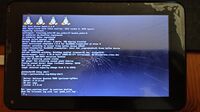GoClever Quantum 700N (goclever-tq700n)
| This device has been tested with postmarketOS, but its device package has not yet been added to the postmarketOS repositories. This means that it cannot be selected in pmbootstrap. |
 GoClever Quantum 700N booting Linux 6.14 | |
| Manufacturer | GoClever |
|---|---|
| Name | Quantum 700N |
| Codename | goclever-tq700n |
| Model | TQ700N |
| Released | 2014 |
| Type | tablet |
| Hardware | |
| Chipset | MediaTek MT8127 |
| CPU | Quad-Core Cortex A7 1.3 GHz |
| GPU | Mali-450 MP4 |
| Display | 1024x600 TFT |
| Storage | 8 GB NAND |
| Memory | 512 MB |
| Architecture | armv7 |
| Software | |
Original software The software and version the device was shipped with. |
Android 4.4.2 |
Extended version The most recent supported version from the manufacturer. |
Android |
| FOSS bootloader | no |
| postmarketOS | |
| Category | testing |
Mainline Instead of a Linux kernel fork, it is possible to run (Close to) Mainline. |
yes |
Flashing Whether it is possible to flash the device with pmbootstrap flasher. |
Broken
|
|---|---|
USB Networking After connecting the device with USB to your PC, you can connect to it via telnet (initramfs) or SSH (booted system). |
Broken
|
Internal storage eMMC, SD cards, UFS... |
Broken
|
SD card Also includes other external storage cards. |
Broken
|
Battery Whether charging and battery level reporting work. |
Broken
|
Screen Whether the display works; ideally with sleep mode and brightness control. |
Broken
|
Touchscreen |
Broken
|
| Multimedia | |
3D Acceleration |
Broken
|
Audio Audio playback, microphone, headset and buttons. |
Broken
|
Camera |
Broken
|
| Connectivity | |
WiFi |
Broken
|
Bluetooth |
Broken
|
GPS |
Broken
|
| Miscellaneous | |
FDE Full disk encryption and unlocking with unl0kr. |
Untested
|
USB OTG USB On-The-Go or USB-C Role switching. |
Broken
|
HDMI/DP Video and audio output with HDMI or DisplayPort. |
Broken
|
| Sensors | |
Accelerometer Handles automatic screen rotation in many interfaces. |
Broken
|
Proximity |
Broken
|
Primary Bootloader Whether it is possible to replace stock bootloader with U-Boot. |
Works
|
|---|---|
Secondary Bootloader Whether it is possible to chainload U-Boot from stock bootloader. |
Broken
|
Mainline Whether latest upstream versions of U-Boot are not broken and it is possible to use them. |
Broken
|
Internal Storage Whether it is possible to boot from internal storage (e.g. eMMC or UFS). |
Works
|
SD card Whether it is possible to boot from SD card. |
Broken
|
USB Host Whether it is possible to boot from a USB storage or connect a keyboard. |
Broken
|
USB Peripheral Whether it is possible to use device as a peripheral in U-Boot, e.g. for fastboot mode. |
Broken
|
Display |
Works
|
Buttons Whether it is possible to navigate in boot menu or grub with volume and power buttons. |
Broken
|
Contributors
Users owning this device
- Illen (Notes: Broken touchscreen)
How to enter flash mode
| WARNING: Leaving the device running fastboot or mainline kernel indefinitely will deplete its battery and brick it if it doesn't have a vendor boot image. |
Run mtkclient with mtk meta FASTBOOT command and connect the powered off device to host. Alternatively you can run adb reboot-bootloader when the device runs Android with USB debugging enabled. Unfortunately mtkclient cannot directly flash the device right now.
Installation
There is no support for NAND, SD or USB in mainline. All you can do right now is just flash the boot image with Linux kernel and pmOS ramdisk, and look at the simple-framebuffer output. It is recommended to back up the vendor boot image first, it can be done with adb pull /dev/block/mtdblock6 boot.img when running Android. The boot partition is only 8 MB, so it is recommended to split initramfs into extra package and use high compression for kernel and ramdisk. Before generating the boot image, you will need to prepend the MediaTek boot header to the kernel and ramdisk using mtk-mkimage from pmaports. Use KERNEL label for kernel and ROOTFS label for ramdisk.
Recovering a bricked device with weak battery and custom boot image
Fortunately it is not hard to recover a bricked device. Connect the device to host and run dmesg -w in terminal, you should see ttyACM0 device appearing and then disconnecting shortly after. After resetting the device (with a button hidden in small hole on back panel, next to the SD card slot) it will appear in dmesg and then disconnect again. You have to reset the device repeatedly, about 5 seconds after each time you see the USB disconnect message, until the battery reaches 3.3V and device starts booting again. Once the screen lights up, quickly reset the device, run mtk meta FASTBOOT command on your host, flash the vendor boot image and reboot. The device should be able to charge by itself from now on.